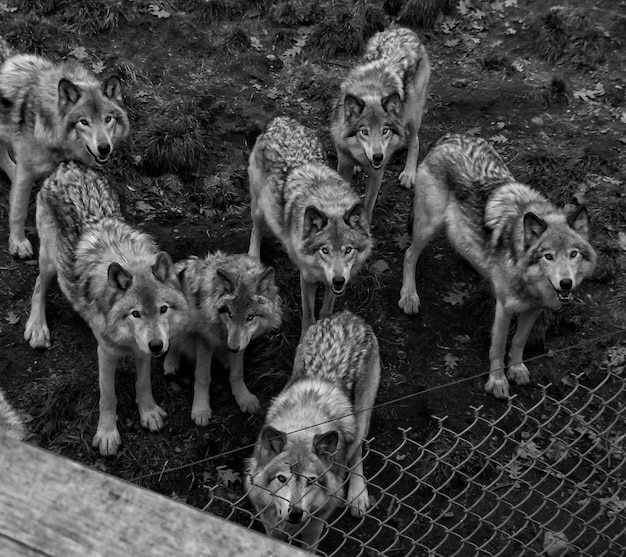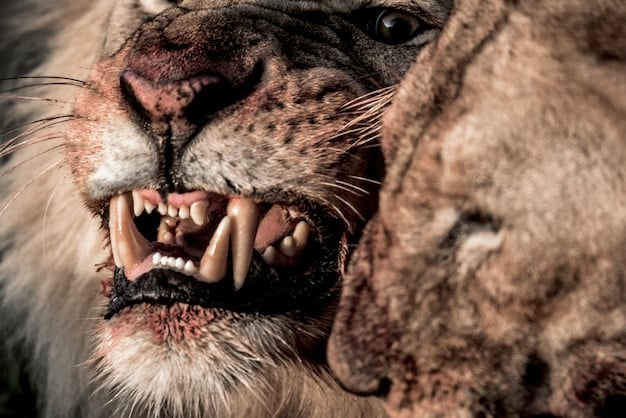Decoding Animal Social Hierarchies: Dominance, Submission, and Survival

Understanding animal social hierarchies involves studying how dominance and submission are established within a group, influencing access to resources, mating opportunities, and overall survival, revealing intricate behavioral strategies.
Ever wondered how animals decide who’s the boss? Understanding animal social hierarchies is crucial for grasping their behavior, survival, and the complex dance of dominance and submission that shapes their communities. Let’s delve in!
What are Animal Social Hierarchies?
Animal social hierarchies are the structured systems within a group of animals that dictate the roles and relationships among them. These hierarchies often determine access to essential resources like food, mates, and territory.
The establishment and maintenance of these hierarchies isn’t random. It involves a complex interplay of communication, competition, and cooperation among individuals. Ultimately, these systems are vital for group stability and survival.
The Basics of Social Structure
Understanding the structure itself is key to understanding the hierarchy. This involves knowing who holds positions of power and how those positions are maintained.
- Dominance: Individuals in dominant positions typically have first access to resources and mating opportunities.
- Submission: Subordinate individuals often display deferential behaviors to avoid conflict and maintain their standing in the group.
- Linear Hierarchies: These are straightforward, where each animal knows its rank relative to others.
Social hierarchies aren’t static; they can shift over time as individuals challenge one another or as the group dynamics change. This constant fluctuation can lead to competitive behaviors and shifts in power.

In summary, animal social hierarchies are the organizational structures that allocate resources and determine roles within a group, crucial for maintaining order and promoting survival.
How Dominance is Established
Dominance isn’t simply a matter of size or strength; it’s often a complex mix of physical prowess, social skills, and strategic behavior. The process of establishing dominance can be intense, involving various forms of competition and display.
Understanding how animals vie for top positions reveals a lot about their social intelligence and the adaptive strategies that have evolved to maintain order.
Physical Displays and Contests
Physical displays and contests are common ways in which animals assert their dominance. These can range from relatively harmless displays of aggression to full-blown physical confrontations.
- Posturing: Erect posture, raised hackles, and other displays of size and strength.
- Vocalizations: Roaring, growling, or other vocal displays to intimidate rivals.
- Direct Combat: Fighting for dominance, often seen in male-male competition, can lead to injury.
The outcome of these contests isn’t always determined by physical strength alone. Factors like motivation, past experiences, and even social support can play a significant role in who emerges as the dominant individual.
Moreover, the long-term effects of dominance contests can have a profound impact on the social structure of the group, shaping the behavior and interactions of all its members.

In conclusion, dominance is established through a combination of physical displays, vocalizations, and direct combat. The interplay of these factors determines the hierarchy in the social structure.
The Role of Submission in Social Hierarchies
While dominance often captures the spotlight, submission is equally critical for maintaining social order. Submissive behaviors prevent constant conflict and help maintain stability within the group.
By understanding the signals of submission, we can gain insight into how animals communicate and avoid unnecessary aggression.
Types of Submissive Behaviors
Submissive behaviors can be subtle or overt, depending on the species and the context. These behaviors serve to signal deference and avoid confrontation.
- Body Posture: Lowering the body, tucking the tail, or avoiding eye contact.
- Vocalizations: Whining, whimpering, or other appeasement calls.
- Grooming: Offering grooming to dominant individuals as a sign of submission.
These behaviors not only help maintain peace but also ensure the survival of subordinate individuals by allowing them to remain within the group without constantly challenging the dominant members.
Understanding the nuanced expressions of submission provides valuable insight into the complex dynamics that underpin animal social hierarchies and the strategies animals use to navigate them.
In conclusion, submission plays a vital role in maintaining social hierarchies, preventing constant conflict, and ensuring the survival of subordinate members.
Benefits of Social Hierarchies
Social hierarchies might seem like a system of winners and losers, but they actually provide numerous benefits for the entire group. These benefits range from resource allocation to reduced conflict.
Let’s explore how these structures help animals thrive and cooperate effectively.
Resource Allocation
One of the primary benefits of social hierarchies is the regulated allocation of resources. Dominant individuals typically have first access to food, shelter, and mates, but this also ensures that the strongest and most capable individuals drive the group.
- Access to Food: Dominant animals can secure the best food sources, ensuring they remain strong and healthy.
- Mating Opportunities: Dominant males often have more opportunities to reproduce, passing on their genes to the next generation.
- Territory Control: Dominant individuals can control the best territories, providing safety and resources for the group.
This system isn’t always fair, but it often results in the most capable individuals leading the group and ensuring its survival.
It allows for an orderly distribution of goods, preventing total chaos and promoting the overall well-being of the group.
In conclusion, social hierarchies offer significant benefits in resource allocation, which helps ensure survival and stability in animal communities.
Drawbacks of Social Hierarchies
While social hierarchies offer certain advantages, they aren’t without their downsides. Subordinate individuals often face significant challenges, and the constant competition for dominance can take a toll.
Let’s consider some of the drawbacks of social hierarchies.
Stress and Competition
Subordinate individuals often experience chronic stress due to their lower status. This stress can affect their health, reproduction, and overall well-being.
- Increased Stress Levels: Constant fear of dominant individuals can lead to elevated stress hormones.
- Reduced Reproductive Success: Subordinates may have fewer opportunities to mate.
- Health Problems: Chronic stress can suppress the immune system, making individuals more susceptible to disease.
The intense competition for dominance can also lead to injuries and even death.
Despite these considerable challenges, many animals find ways to navigate these drawbacks and ultimately survive and reproduce within the social hierarchy.
In summary, social hierarchies can lead to increased stress, reduced reproductive success, and health problems for those lower in the social structure.
Examples of Social Hierarchies in Different Species
Social hierarchies are found across a wide range of animal species, from insects to mammals. Each species has its unique way of organizing and maintaining these structures.
Let’s explore some notable examples to illustrate the diversity and complexity of animal social hierarchies.
Bees
Honeybees have a rigid caste system, with a queen, worker bees, and drones. The queen is at the top, responsible for reproduction, while worker bees perform various tasks to support the colony, and drones exist solely to mate with the queen.
Wolves
Wolves typically live in packs with a clear alpha male and female. These alpha individuals lead the pack, control resources, and are primarily responsible for reproduction, while other pack members follow their lead and cooperate in hunting and raising pups.
Chickens
The term “pecking order” comes from chicken social hierarchies, where dominant chickens peck subordinate ones. This behavior establishes a hierarchy that determines access to food and roosting spots.
These examples demonstrate how social hierarchies are tailored to the specific needs and environments of different species.
Overall, examining social dynamics in different species emphasizes how fundamental hierarchical structure is to animal organization and behavior.
| Key Concept | Brief Description |
|---|---|
| 👑 Dominance | Higher-ranking animals have first access to resources and mates. |
| 🤝 Submission | Subordinate animals use behaviors to avoid aggression from dominant individuals. |
| 🍎 Resource Allocation | Dominant individuals typically have better access to essential resources. |
| 📉 Stress | Lower-ranking animals may experience high stress levels, impacting their health. |
Frequently Asked Questions
▼
A social hierarchy is a system within a group of animals that dictates roles and relationships, often determining access to resources like food and mates.
▼
Dominance is established through physical displays, vocalizations, and sometimes direct combat. Also, past experiences play a role.
▼
Signs of submission include lowering the body, tucking the tail, and avoiding eye contact with dominant individuals. Vocalizations such as whining and grooming are also common.
▼
No, while social hierarchies can provide benefits like resource allocation, they also can cause stress and reduced reproductive opportunities for subordinate members.
▼
Yes, social hierarchies are dynamic and can change as individuals challenge one another or as the group dynamics evolve due to external and internal variables.
Conclusion
Understanding animal social hierarchies reveals the fascinating strategies animals use to organize their societies and allocate resources. From dominance displays to submissive behaviors, these hierarchies play a crucial role in their survival and reproductive success, despite the inherent drawbacks for subordinate individuals.





